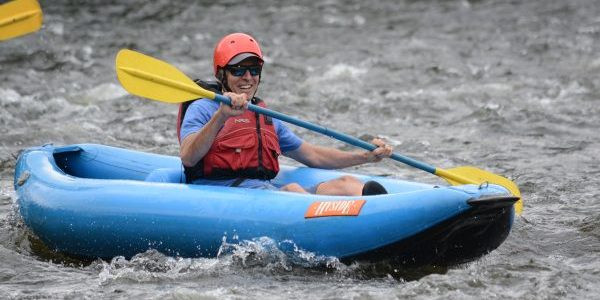What is a Funyak?
The word “funyak” has come to mean several things through marketing and whitewater product development. Some consider a funyak to be a molded plastic boat made for lakes and ponds – fun “touring” kayak, essentially. However, most consider a “Funyak” to be an inflatable whitewater craft, appearing and functioning similar to a white water river kayak – a “fun” kayak. They are built for fun and stability for whitewater trips.
Funyaks are stable whitewater craft designed to bring the possibility of river kayaking to novice paddlers. Individuals can buy an inexpensive Funyak to use on lakes or on mild whitewater. They are easily transported and easy to maneuver through mild rapids. They do not require a skirt over a closed cockpit which seals in the paddler. The cockpit in a Funyak is open so the Eskimo roll is not necessary to right the boat while still in it. The open cockpit Funyak is stable and rarely turns over in mild rapids and is easily righted if it capsizes. A further advantage of Funyaks is the soft material – rather than a hard plastic shell as on a “Sit-On-Top” plastic kayak, the soft material is comfortable and allows you to stretch out and recline between rapids or paddling sections. There is also room in the cockpit to carry items for a short whitewater excursion – food, drink, extra gear, squirt guns, etc.
Funyaks come in many different models, sizes and have a wide price range. Inexpensive inflatable kayaks can cost under $200 each. These will not last long as construction is cheap and patching the cheaper materials is difficult and not permanent. High end inflatable kayaks, “Funyaks” can retail for over $1,200 for one person boats and over $1,500 for two person boats. These more expensive crafts are used by outfitters such as Crab Apple Whitewater Rafting in New England. This choice is due to the combination of the Funyaks’ durability and stability for guest use. These craft can last for last for many, many seasons without ever being patched or repaired.
Funyaks were originally designed for folks that have little or no kayak or whitewater experience. The Funyaks were stable, with a wide beam, open cockpit and had a standard or non-bailing floor. Buckets or pails were used to remove water from the bottom of the Funyaks if they took on water in rapids. Self-bailing Funyaks became the norm in the 1990’s – these allow water to enter the raft, but quickly drain out by having an inflated floor that runs water out through drain holes. This floor design change allows a wider variation on Funyak models and design. With a self-bailing floor, boats can still be made to be very stable for folks new to paddling whitewater rivers and they can be advanced to take on big whitewater challenges – up to Class IV and V whitewater rapids for expert paddlers.
Funyaks can range in size from roughly 10 feet to 14 feet in length. The width or beam ranges from 2.5 feet to 3.5 feet on most models. Funyaks can weigh 25-45 pounds depending on material and size. More rugged material will weigh more – and last longer in the whitewater rapids. Funyaks can be stored or transported laying flat or rolled up tight.
Article by Frank Mooney, Crab Apple Whitewater Rafting
Deerfield River guide since 1990, Millers River guide since 1991, Kennebec River guide since 1991, Dead River guide since 1991, West River guide since 1991
